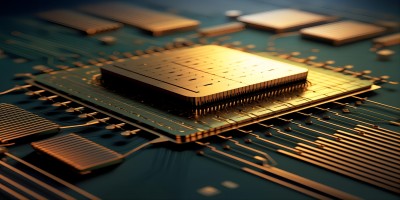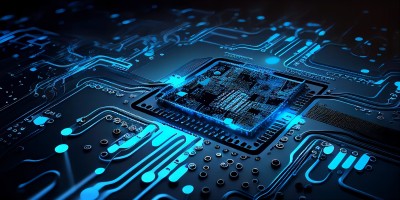The chip is one of the greatest inventions of our time. Without the emergence of chips, it is difficult to imagine what the current electronic age would be like. It is precisely because of the invention of chips that all functions are concentrated on a small chip.
1、 Chip Concept Description
A chip is the carrier of an integrated circuit, separate from a chip and typically an important component of a computer or other electronic device. Simply put, the chip integrates electronic components such as resistors and capacitors that can be seen everywhere, as well as the circuits composed of them, into a small particle. The process of chip manufacturing is like building a house with building blocks. Firstly, using chips as the foundation, you can achieve the desired shape (i.e. various types of chips) by stacking them layer by layer. A chip is a very precise instrument, measured in nanometers. For an ordinary Intel Core CPU, the size of the core is similar to that of a human nail, but it integrates billions or even tens of billions of transistors. There are many types of chips. A series of interrelated chips can be combined into a chipset. They are interdependent and can play a greater role when combined. For example, the signal sending and receiving module in a smartphone consists of multiple chips. Larger integrated circuits together.

Chips are widely used in our daily lives, and different types of chips play different roles. Chips are like the human brain, receiving information, issuing commands, and controlling human behavior. If the CPU is compared to the brain of the entire computer system, then the chipset composed of the CPU and other chips constitutes the entire body's trunk. For computers, chipsets almost determine the functionality of the entire system. Not only do smart products such as smartphones and computers contain chips, it can be said that as long as more complex functions are involved, they will be used.
2、 Classification of chips
The following figure shows the classification of common chips, including ASIC, ASSP, SoC, FPGA, SoC FPGA μ Controller μ Processors, etc.

General Integrated Circuit
ASIC (Application Specific Integrated Circuit) is an integrated circuit built specifically for specific applications or purposes. Compared to programmable logic devices or standard logic integrated circuits, ASICs can improve speed because they are specifically designed to accomplish something and can achieve this. It can also be made smaller and consume less electricity. The disadvantage of this circuit is that it has higher design and manufacturing costs, especially when only a few units are needed.
ASIC can be found in almost any electronic device, ranging from custom image rendering to sound conversion. As ASICs are customized, they can only be used by the company that designed them, so they are considered proprietary technology.
ASSP: Specialized standard product. The design and implementation of the Specialized Standard Product (ASSP) is identical to that of ASIC. This is not surprising, as they are essentially the same. The only difference is that ASSP is a more versatile device suitable for multiple system design studios. For example, independent USB interface chips can be classified as ASSP.
SOC is the abbreviation for System on Chip. Since it is a system, a single system cannot be referred to as a system. Only a combination of multiple individuals can be called a system. Therefore, SOC emphasizes a holistic approach. SoC mimics a computer system and is simplified into a microsystem. In the SOC chips I have encountered, the basic components of hardware are the core, memory, peripheral interfaces (high-speed and low-speed peripheral devices), bus, interrupt module, clock module, and so on.
Field Programmable Gate Array: A field programmable gate array is a semiconductor device composed of a configurable logic block matrix connected through programmable interconnections. After the FPGA is manufactured, it can be reprogrammed according to the required application or functional requirements. This feature is the key to distinguishing between FPGA and Application Specific Integrated Circuit (ASIC). You can customize FPGA devices for specific design tasks. Although there are disposable programmable (OTP) FPGAs in the market, they are mostly based on SRAM and can be reprogrammed as design evolves.
Programmable SoC or SoC FPGA: An IC that integrates a processor and FPGA architecture is called a programmable SoC or SoC FPGA. This also includes peripheral devices, on-chip memory, FPGA style logical arrays, and high-speed transceivers. Mainly used in fields such as networks, aerospace, and national defense.
Microprocessor( μ P or MPU): An IC that only contains a processor is called a microprocessor. It does not contain memory (RAM, ROM, etc.) or any other peripheral devices.
Microcontroller( μ C or MCU: An IC that includes a processor, memory (RAM, ROM, etc.), and other peripheral devices is called a microcontroller. This is a general-purpose device that requires programming for the application. Microcontrollers can be used in various industrial products. The microcontroller is a simplified version of SoC.
3、 How are chips designed and manufactured?

chip design
Normative development
Within a chip design company, the first step in designing a chip is to draft proposals through management and data analysis, so that the design meets industry segmentation requirements from the beginning. At this point, senior designers will hold a meeting to conduct feasibility analysis, and based on this, determine the functions and operating modes of the chip, as well as the main design parameters such as performance, function, physical dimensions, manufacturing technology, and design technology.
Architecture Definition
Define the basic specifications of the system, such as floating point units; Determine the system to be used, such as Reduced instruction set computer (RISC) or Complex Instruction Set Computer; Finalize the number of ALU cache sizes, etc.
Featured design
Define the main functional units of the system to help determine the interconnection requirements between units, as well as the physical and electrical specifications of each unit.
logic design
The expression, control flow, word width, register allocation, etc. of the Kaiser, and Describing function in the code using VHDL or Verilog HDL Hardware description language to form Register-transfer level (RTL) code.
circuit design
The logic design provides a simplified logic implementation, while the circuit design further expresses the logic in the form of a netlist. A grid meter usually consists of gates, transistors, and various interconnections. The effect of circuit design can be obtained through simulation.
physical design
In this step, the transformation of the net table to its geometric representation is achieved, and the result is called layout, which can functionally verify the synthesized net table. This step follows some predefined fixed rules, such as lambda rules, which provide precise details such as component size, proportion, and spacing. The next step is to verify the functionality and timing of the physical layout of the completed wiring. Validation projects typically include LVS, DRC, ERC, etc., as well as some power consumption analysis and manufacturability analysis.
Design process export
This is the final step in chip design. Export design process files according to the requirements of the chip foundry. The design company has retained the original design draft and can make flexible modifications, while the physical layout of the final process files is based on GDS II files. This format was handed over to the chip foundry as the manufacturing foundation.
Manufacturing and Testing

Refined single crystal silicon ingot
Sand is the cheapest source of silicon, so the silicon used in semiconductor materials is extracted from sand (silica ₂) Usually, companies producing monocrystalline silicon ingots extract silicon from sand and then undergo high-temperature molding and multiple purification to obtain electronic grade silicon (EGS) with a purity of 99.9999%. Then melt pure silicon in a pot at 1400 º C, insert small seed crystals containing the desired crystal orientation into the molten silicon, and slowly pull out (1mm/min) to make the silicon crystals into cylindrical single crystal silicon ingots. The weight of a single monocrystalline silicon ingot is approximately 100kg.
Wafer processing
Wafer processing mainly includes two steps. The first step is to horizontally saw the single crystal silicon ingot into a disk, then polish and crystallize it to obtain a mirror shaped wafer. The second step is to thermally oxidize the wafer. At this point, pure silicon will form a very thin layer of silicon dioxide on the surface through a high-temperature furnace filled with oxygen, serving as the gate oxide layer of the transistor.
Photolithography
The so-called lithography process includes two parts: mask and lithography. Firstly, photoresist capable photoresist is applied to the chip to form a circuit pattern on the surface of the silicon substrate. Then, a light aligner is used to align the chip with the mask, and the chip will pass through the hollow part of the mask. When exposed to ultraviolet light, the exposed part of the photoresist becomes soluble, causing the circuit structure on the mask to be temporarily copied onto the silicon substrate.
etching
According to the circuit structure carved by the Stepper, micro engraving, grooves or contact holes are carried out on the silicon chip. Specifically, etching involves using the developed photoresist pattern as a mask, and then etching a certain depth of thin film material on the substrate using a chemical liquid or plasma to obtain an integrated circuit pattern that is the same as the photoresist pattern.
ion implantation
Ion implantation is an important doping technology in chip manufacturing and an important means of controlling the threshold voltage of MOSFETs. Generally, in vacuum and low-temperature environment, impurity ions of Phosphine or Boron trichloride are accelerated to obtain impurity ions with certain kinetic energy, and then the ion beam is photographed on the wafer covered with photoresist mask. The part covered by the photoresist, where the ion beam cannot penetrate the photoresist and is blocked; In the uncovered part, ion beams will be injected into the substrate to achieve doping, and the doping depth depends on the energy of the ion beam. Finally, after ion implantation is completed, the photoresist must be thoroughly removed before proceeding to the next step.
Metallization
Metallization refers to the process of depositing a metal film on a wafer through methods such as deposition, and then forming surface metal connections through metal film photolithography, connecting various components together. Therefore, the first step is to etch the contact holes. The second step is to prepare a metal film. The main conductive metal material can be aluminum alloy or gold. The methods typically include evaporation, sputtering, metal CVD, and electroplating. At present, metal CVD has strong step coverage and good high aspect ratio. The contact and gapless filling characteristics are widely used. The third step is to use photolithography and etching processes or stripping techniques to remove parts outside of the wiring to form interconnected metal wires. The fourth step is to perform alloying heat treatment to ensure good conductivity between the chip and the metal. Finally, planarization reduces the damage of uneven surface of the chip to the accuracy of light propagation, thereby affecting its precise pattern production. When the metal layer increases, this process is not only used for the surface layer, but also for the intermediate layer.
wafer test
After the chip carrying the integrated circuit is processed, it needs to be tested. The main purpose is to reduce packaging costs and screen out problematic integrated circuit modules (chip prototypes) as soon as possible. The specific operation is to use the probe test platform to test the electrical performance of the chip prototype according to the predefined Test point in the clean room. This test can perform one-time testing on chips on the testing platform through fixtures, without the need to execute each chip individually, resulting in high testing efficiency.
Cutting and packaging
Each chip contains hundreds to tens of thousands of chips. Cut the chip into individual pieces using a diamond saw, perform thinning treatment, and then conduct electrical testing on each individual chip (chip). If there are any issues with the test results, the chip will be discarded; If the test results are satisfactory, the chip will be sent for packaging. Before packaging, the chip will be rechecked using a microscope, and only the chip that passes the recheck will be truly packaged.
Packaging testing
For chips, pre factory testing mainly includes three aspects. The first two are wafer testing and chip testing, which have been described in the previous section (refer to the "Cutting and Packaging" chapter). The focus here is actually the third test: packaging testing, which is the testing before the chip leaves the factory. According to statistics, these three tests will account for 1/4 to 1/2 of the entire chip production cost.
At this point, the chip to be tested has been wrapped in a layer of packaging and is not as fragile. Therefore, the requirements for the testing environment are not as strict, and there is no need for clean room testing. However, for packaging testing, due to the obstacles of the packaging itself, the test probe cannot contact the inside of the chip, the testing range is limited, and the complexity of testing also increases.
General chip packaging testing includes various electrical characteristic tests, such as power consumption, heat generation, operating speed, and withstand voltage in various environments. During the testing process, a large amount of programming and programming verification programs are often required. Sometimes, according to customer requirements, targeted tests are conducted to see if the customer's needs are met. When the test results are normal, the chip will be marked with specifications, model number, and production date on a screen, and packaged and shipped.
4、 Summary
There are many types of ICs, and each type has certain characteristics: programmable or non programmable, with or without a processor, high or low speed, compact or bulky. The process of designing, manufacturing, and testing integrated circuits is complex and detailed. The main contributors are the design and validation team, IP suppliers, and IC manufacturers. Advanced EDA tools play a crucial role in reducing the time and effort associated with the IC design cycle.



